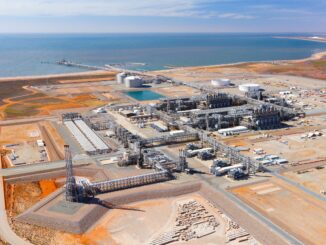
Los Angeles, CA – October 3, 2025 – A massive explosion followed by a towering inferno rocked Chevron’s El Segundo refinery late Thursday night, sending flames and thick smoke billowing into the night sky visible for miles across the South Bay area.
The incident, which prompted shelter-in-place orders for nearby residents in Manhattan Beach, has raised concerns about air quality and potential disruptions to Southern California’s fuel supply.
The fire erupted around 8:30 p.m. local time at the refinery, located just south of Los Angeles International Airport (LAX).
Witnesses reported hearing a loud blast that shook homes, with some describing it as feeling like an earthquake or even a “nuke.”
Video footage captured enormous orange flames shooting high above the facility, illuminating the surrounding neighborhoods.
Chevron’s on-site fire department responded immediately, supported by local fire crews from the Los Angeles County Fire Department.
No injuries were reported, and while no widespread evacuations were ordered, authorities advised residents to close windows and stay indoors due to smoke concerns.
Governor Gavin Newsom and Los Angeles Mayor Karen Bass stated they were closely monitoring the situation, with state and local agencies coordinating to ensure public safety.
Got Tax in 2025?
Potential Causes and Ongoing Investigation
The exact cause of the explosion and fire remains under investigation, with no official details released as of early Friday morning.
Preliminary reports indicate the blaze originated in the refinery’s Isomax 7 unit, a hydrocracking system responsible for converting mid-distillate fuel oil into jet fuel.
Refinery fires can stem from various factors, including equipment malfunctions, process upsets, or human error, but experts caution against speculation until a full probe is completed. Chevron has not commented on the root cause, focusing instead on containment and safety.
The U.S. Chemical Safety and Hazard Investigation Board (CSB) may get involved if the incident is deemed significant, as they have in past refinery accidents.
❗️🇺🇲 – Major Explosion and Fire at Chevron Refinery in El Segundo, CA
A massive explosion has just rocked the Chevron oil refinery in El Segundo, California—just south of Los Angeles International Airport (LAX)—triggering a large-scale fire that’s visible for miles.
Emergency… pic.twitter.com/jEt1OM9WIQ
— 🔥🗞The Informant (@theinformant_x) October 3, 2025
Damage Assessment
Damage assessments are still preliminary, given the recency of the event. The fire was contained by early Friday, but flames caused visible structural impact to the affected unit, with potential spillover to adjacent areas.
Chevron officials have not disclosed the full extent of the damage, but industry analysts note that refinery fires of this magnitude often require weeks or months for repairs, depending on the severity.
No environmental spills were reported, though air quality monitoring is ongoing due to the release of smoke and potential pollutants.
Production Offline and Supply Disruptions
Chevron’s El Segundo refinery is a critical asset in California’s energy infrastructure, with a rated capacity of 290,000 barrels per day (BPD) of crude oil processing, typically operating at around 280,000 BPD.
|
Product Category
|
Percentage of Output
|
Estimated Daily Production (BPD)
|
|---|---|---|
|
Gasoline
|
45%
|
~110,000
|
|
Jet & Diesel
|
41%
|
~100,000
|
|
Fuel Oils & Coke
|
10%
|
~25,000
|
|
LPG
|
4%
|
~9,000 |
The fire’s origin in the jet fuel processing unit suggests that jet fuel production could be most directly impacted.
While exact figures on offline capacity are not yet available, the refinery supplies approximately 20% of Southern California’s motor vehicle fuels (including gasoline and diesel) and a staggering 40% of the region’s jet fuel.
If the Isomax unit remains down, it could sideline tens of thousands of barrels per day of jet fuel output, though gasoline and diesel production might see minimal direct effects unless broader shutdowns are required for safety inspections.Analysts estimate that a partial shutdown could remove 50,000–100,000 BPD of combined fuels from the market in the short term, based on similar past incidents.
However, Chevron has not confirmed any production halts beyond the immediate response.
Estimated Impact on Consumers
The potential ripple effects on consumers are significant, particularly in a state already grappling with high fuel prices. Southern California relies heavily on local refining, and any disruption at El Segundo could lead to tighter supplies and upward pressure on prices at the pump.
Gasoline and diesel users might see modest increases—potentially 10–20 cents per gallon in the coming weeks—if alternative supplies from other refineries or imports can’t fully compensate.
Jet fuel shortages pose a greater risk to aviation, possibly affecting flight operations at LAX and other regional airports, with airlines facing higher costs that could trickle down to ticket prices. Local residents are already voicing concerns about air quality, with social media buzzing about the smoke plume.
Environmental groups are calling for thorough monitoring to assess any long-term health impacts. As the investigation unfolds, energy markets will be watching closely for updates on when the refinery can resume full operations. Energy News Beat will continue to monitor this developing story and provide updates as more information becomes available. For now, the incident serves as a stark reminder of the vulnerabilities in our energy supply chain.
This is a perfect example of a problem that California would face if the other two refineries close, namely that they could be forced to pay $10 for gasoline due to disruptions like this, which is not good for the supply side of the business.
Got A Tax Burden in 2025?
Crude Oil, LNG, Jet Fuel price quote
ENB Top News
ENB
Energy Dashboard
ENB Podcast
ENB Substack






Be the first to comment